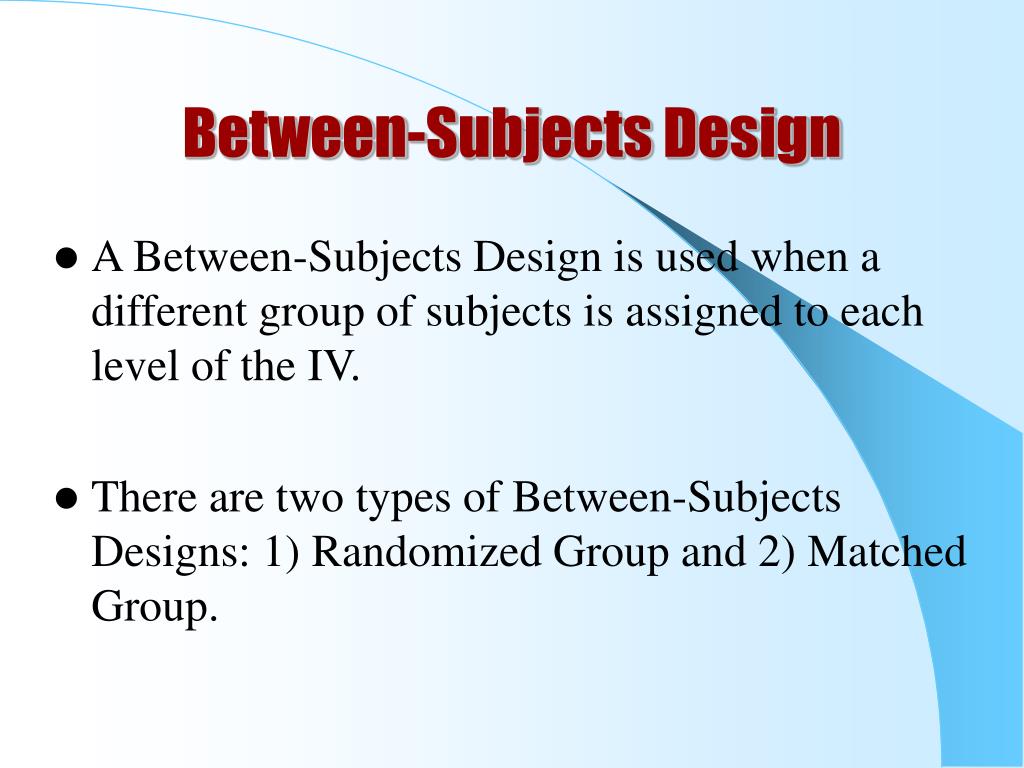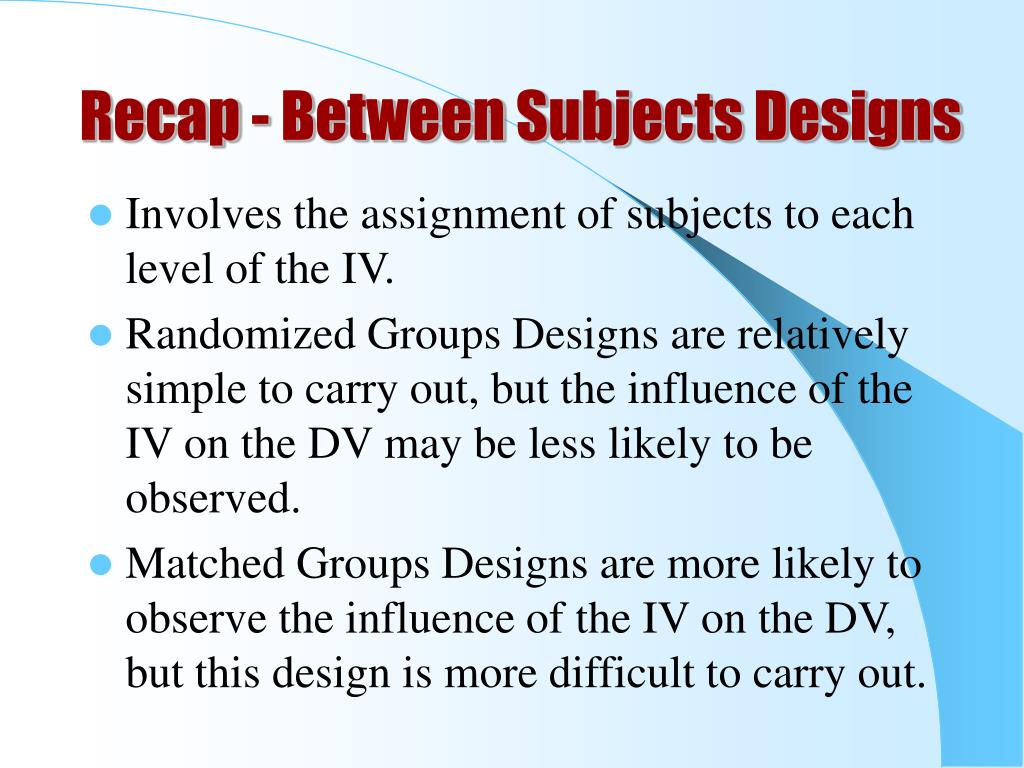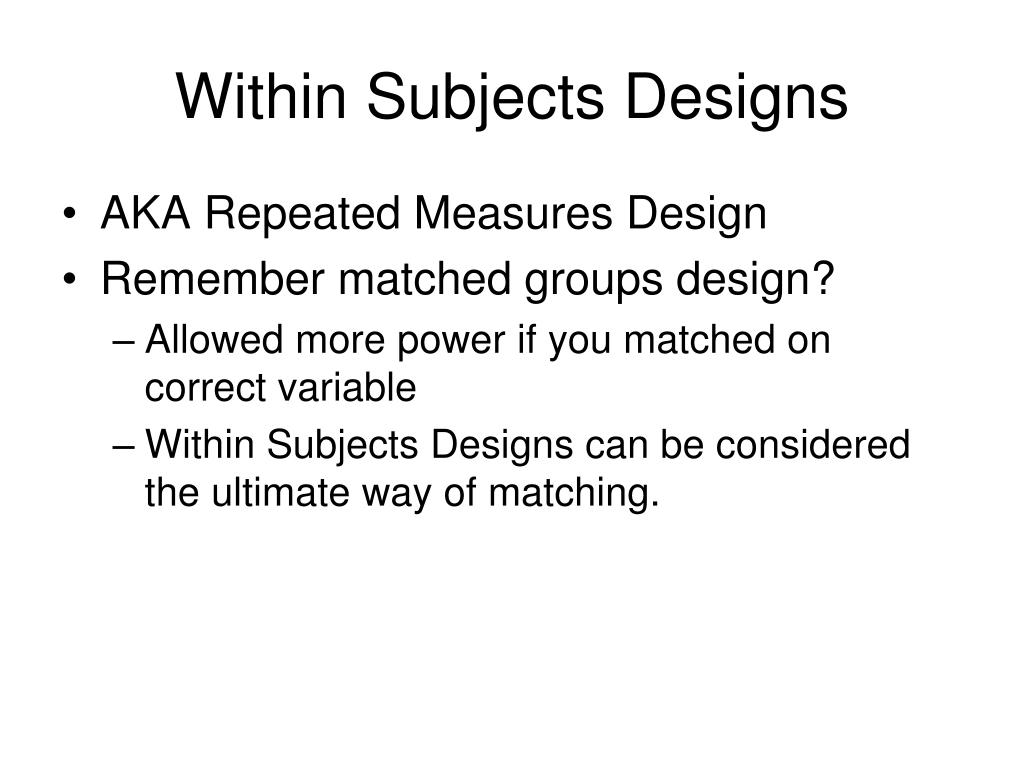Table Of Content

The degrees of freedom for the interaction is the product of the degrees of freedom for the two variables. For the \(Gender \times Task\) interaction, the degrees of freedom is the product of degrees of freedom Gender (which is \(1\)) and the degrees of freedom Task (which is \(2\)) and is equal to \(2\). Remember also that using one type of design does not preclude using the other type in a different study. There is no reason that a researcher could not use both a between-subjects design and a within-subjects design to answer the same research question.
Research Methods in Psychology
National parochialism is ubiquitous across 42 nations around the world - Nature.com
National parochialism is ubiquitous across 42 nations around the world.
Posted: Thu, 22 Jul 2021 07:00:00 GMT [source]
However, placebos can also have a positive effect on disorders that most people think of as fundamentally physiological. There is even evidence that placebo surgery—also called “sham surgery”—can be as effective as actual surgery. Choosing the right experiment design is an important aspect of research, as it determines the structure and organization of the study. It can also have a significant impact on the reliability and validity of the results. Between-subjects cannot be used with small sample sizes because they will not be statistically powerful enough.
Within-Subject Designs
This should be done by random allocation, ensuring that each participant has an equal chance of being assigned to one group. This means they may be able to figure out how to game the results to do better in the experiment. This can skew the results and make it difficult to determine if any effect is due to the different levels of the treatment or simply a result of practice. There are a few different advantages to using a within-subject design when conducting a psychology experiment. Comparing the spending of the same participants in both conditions makes it possible to assess whether the shopping experience affects spending habits. A participant who tests a single car-rental site will have a shorter session than one who tests two.
Carryover Effects and Counterbalancing
This study design is coined “within-subjects” because conditions are compared within the same group of participants. On the other hand, a between-subjects design is the opposite of a within-subjects design where the differences in conditions occur between the groups of subjects. Within-subjects designs are suitable for establishing correlations or causality between variables, even with small sample sizes.
Within-Subject Designs Require Fewer Participants
The within-subjects design has advantages and disadvantages, which can affect the validity and reliability of the results. One of the simplest within subject designs is opinion - watch any formalized debate and you will see the process. The chairperson will take a vote before the debate, to establish a baseline opinion, and will ask the audience to vote again at the end. The team that gained the most votes obviously managed to sway opinion in the same subjects much better, so can be announced as the winner. Randomisation and counterbalancing of the order of conditions can help reduce carryover effects. To assess changes in perception, you compare differences in survey responses over time within subjects.
It is always possible that just by chance, the participants in one condition might turn out to be substantially older, less tired, more motivated, or less depressed on average than the participants in another condition. One is that random assignment works better than one might expect, especially for large samples. Another is that the inferential statistics that researchers use to decide whether a difference between groups reflects a difference in the population takes the “fallibility” of random assignment into account. Yet another reason is that even if random assignment does result in a confounding variable and therefore produces misleading results, this is likely to be detected when the experiment is replicated. The upshot is that random assignment to conditions—although not infallible in terms of controlling extraneous variables—is always considered a strength of a research design.

One-Factor Designs
Between-subjects designs have the advantage of being conceptually simpler and requiring less testing time per participant. Within-subjects designs have the advantage of controlling extraneous participant variables, which generally reduces noise in the data and makes it easier to detect any effect of the independent variable upon the dependent variable. Within-subjects designs also require fewer participants than between-subjects designs to detect an effect of the same size.
The relationship between time to diagnose and diagnostic accuracy among internal medicine residents: a randomized ... - BMC Medical Education
The relationship between time to diagnose and diagnostic accuracy among internal medicine residents: a randomized ....
Posted: Wed, 21 Apr 2021 07:00:00 GMT [source]
Within Subject Design

A within-subjects design is more statistically powerful than a between-subjects design, because individual variation is removed. To achieve the same level of power, a between-subjects design often requires double the number of participants (or more) that a within-subjects design does. When comparing different treatments within subjects, you should randomise or counterbalance the order in which every condition is presented across the group of participants.
(Does the attractiveness of one person depend on the attractiveness of other people that we have seen recently?) But when they are not the focus of the research, carryover effects can be problematic. Imagine, for example, that participants judge the guilt of an attractive defendant and then judge the guilt of an unattractive defendant. If they judge the unattractive defendant more harshly, this might be because of his unattractiveness. But it could be instead that they judge him more harshly because they are becoming bored or tired. The attractive condition is always the first condition and the unattractive condition the second. Thus any difference between the conditions in terms of the dependent variable could be caused by the order of the conditions and not the independent variable itself.
Because the same participants are used in all conditions, each participant serves as their own control. Researchers can control for order effects by counterbalancing the order in which the different levels of the independent variable are presented to participants. The within-subjects design allows for higher statistical power and requires fewer participants, but it is vulnerable to carryover and order effects, which can compromise the internal validity of the study.
An experimental design in which the independent variable is a within-subjects factor is called a within-subjects design. The designs we have covered so far in the book are all between-subjects designs, meaning each participant is assigned into one condition and being tested under one condition only. When we compare whether the treatments yield different outcomes, we are compare between participants or subjects from different treatment conditions, thus the name between-subjects design. In this chapter, we will look at a different type of design, where each participants will be assigned into multiple treatments. Between-subjects and within-subjects designs can be combined in a single study when you have two or more independent variables (a factorial design).
So far, we have discussed an approach to within-subjects designs in which participants are tested in one condition at a time. There is another approach, however, that is often used when participants make multiple responses in each condition. Imagine, for example, that participants judge the guilt of 10 attractive defendants and 10 unattractive defendants. Instead of having people make judgments about all 10 defendants of one type followed by all 10 defendants of the other type, the researcher could present all 20 defendants in a sequence that mixed the two types.
It helps to control for extraneous variables and reduce the influence of individual differences on the results. Within-subjects designs have more statistical power due to the lack of variation between the individuals in the study because participants are compared to themselves. A within-subject design involves having all participants exposed to the exact same treatments.
This design allows researchers to understand the effects of two independent variables (each with two levels) on a single dependent variable. Factorial designs are a type of experiment where multiple independent variables are tested. Each level of one independent variable (a factor) is combined with each level of every other independent variable to produce different conditions. A within-subjects design allows researchers to assign test participants to different treatment groups. In a within-subjects design, each participant experiences every condition of the independent variable. The choice of experimental design will affect the type of statistical analysis that should be used on your data.
Consider an experiment on the effect of a defendant’s physical attractiveness on judgments of his guilt. Again, in a between-subjects experiment, one group of participants would be shown an attractive defendant and asked to judge his guilt, and another group of participants would be shown an unattractive defendant and asked to judge his guilt. In a within-subjects experiment, however, the same group of participants would judge the guilt of both an attractive and an unattractive defendant. A 2×2 within-subjects design is one in which there are two independent variables each having two different levels.
To demonstrate this, he asked one group of participants to rate how large the number 9 was on a 1-to-10 rating scale and another group to rate how large the number 221 was on the same 1-to-10 rating scale (Birnbaum, 1999). Participants in this between-subjects design gave the number 9 a mean rating of 5.13 and the number 221 a mean rating of 3.10. According to Birnbaum, this is because participants spontaneously compared 9 with other one-digit numbers (in which case it is relatively large) and compared 221 with other three-digit numbers (in which case it is relatively small). The first few chapters provided an overview of different types of studies and the different variables that one needs to understand to design a study were explained.

No comments:
Post a Comment